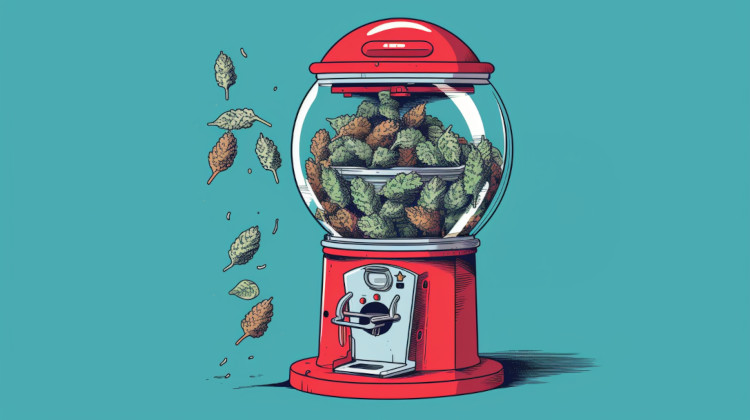Cannabis consumption has come a long way in just a few short decades. For the majority of the 20th century, most people in the US only associated cannabis with smoking, or the occasional "special" brownie. In the past few decades, edibles have asserted themselves in the marketplace, progressing from being exclusive to infused butter, brownies, and sweets to being available in almost every food or beverage imaginable.
THC gum is one of the most exciting products to hit the market in recent years. This relatively new way to use cannabis is showing ample promise for many consumers, offering a new, discreet, and versatile way to enjoy cannabis virtually anywhere.
What is THC Gum?
THC gum, also known as weed gum, is a product that hit the market a little under a decade ago, with some patents filed in the spring of 2015. Essentially, it's your standard pack of gum but infused with cannabinoids – most often THC. By infusing the active compound found in cannabis into the gum, clever manufactures created an edible that breaks many of the norms of typical edibles. Instead of actually eating the gum (and the cannabinoids it contains), users can absorb plant compounds through the oral mucosa, using the same quicker absorption pathways as sublingual sprays and tinctures.
Weed gum works like other tinctures or edibles in that the consumer can experience the intoxicating effects of THC without having to smoke or vaporize the product. This allows for discrete consumption without bothering anyone in the surrounding area.
Most infused gum products today come in classic mint or bubble gum flavors. But it wouldn't be shocking to see other flavors hitting the market soon if they haven't already.
How Potent is THC Gum?
Dosing for THC gum typically follows standard state laws. That means most weed gum will come in a 5 to 10 mg serving per piece, with most packs maxing out at 100 mg. Some states allow for higher dosage thresholds for medical consumers, which could see some gums totaling 20 mg per stick.1
There have also been occasions where products vastly exceed that dosage threshold, including some totaling 7000 mg per package.2 But, if these products adhere to most laws, the per-piece dosage will likely max out at 20 mg or less.
Check your state laws and product information before making any purchases.
What are the Effects of Weed Gum?

Edible gum is intended to act as a sublingual (under-the-tongue) method of consumption, similar to a tincture or CBD oil. In this case, the substance is held under the tongue, allowing the compounds to be absorbed directly into the bloodstream for a fast and potent effect. Sublingual onset times vary between 15 and 45 minutes, with effects lasting six to eight hours in many cases.3
But that's only half the answer. THC gum may also act like a standard weed edible. As such, consumers may feel that their gum experience matches that of an everyday infused food or beverage. With that being the case, consumers should expect a delayed onset effect when using edible gum. Typically, individuals may feel the effects within 60 to 180 minutes after chewing your gum.
Once the effects are felt, consumers may expect a more substantial, longer-lasting high due to how the cannabis is metabolized in the body, with the liver converting THC into a more potent substance – 11-hydroxy-THC.. These effects typically last between six to eight hours.3 However, some edibles have reduced their onset time thanks to processes like nanoemulsion. If that's the case, the edible could take effect in roughly 10-15 minutes.
What are the Advantages of THC Gum?

Weed gum presents several advantages over smoking. Discretion is a primary benefit. This benefit cuts down on public attention and can help reduce stigmas lingering around anyone concerned about cannabis smoke, vape clouds, or anything of the like.
More so, THC gum has shown some potential in the medical space. There is a belief that cannabis gum could provide various therapeutic oral health benefits. While research is limited, some feel that THC gum could provide analgesic and anti-inflammatory benefits to consumers.4 Regulated edibles are also believed to help deliver more consistent dosing, reducing or eliminating worries over detrimental results tied to under or over-dosing, but even legal states have their challenges with edible dosing.5
What are the Disadvantages of Weed Gum?
The biggest knock to weed gum is its questionable results. This concern is particularly valid if cannabis gum acts more like a sublingual than an edible.
Select research has indicated that sublingual effects may not live up to smoking, a preferred method among most consumers.6 Additionally, research has called into question the efficacy of sublingual administration. One study questioned whether oral mucosa consumption delivers cannabinoids directly to the bloodstream.7 Meanwhile, other studies have asked if sublingual delivery actually occurs or if the cannabinoid is instead swallowed like an edible.8
Edibles Gum: Best Products Available Now

You'll want to follow some standard cannabis shopping best practices when looking for your weed gum. Look for items that come from reputable retailers, either online or in-store. That means shopping from licensed shops with positive buyer reputations. Be sure to do your research.
When researching stores, also brush up on the brands. Make sure that the brand is legal to sell in your state. More so, be on the lookout for any certificate of analysis (CoA) to verify the cannabinoid content of their products. Usually, you can find these on the QR code provided on the box. If not on the box, check the company website. If you need help finding the information on either source, wait to purchase it until you get further clarity.
Depending on your state or country, you can find a range of products to choose from. While THC gum is a bit more niche, there are several brands you can check out in certain parts of the world. Consider kicking your research off by checking out a few of these popular brands:
- LEVEL CBD-infused gum
- Joyibles
- Creator's Choice (Available in Canada)
References
- Peralt A, Ke P, Castaneto MS. Impact of cannabis‐infused edibles on public safety and regulation. Journal of Forensic Sciences. 2022;67(6):2387-2393. doi:https://doi.org/10.1111/1556-4029.15135
↩︎ - Steigerwald S, Wong PO, Khorasani A, Keyhani S. The Form and Content of Cannabis Products in the United States. J Gen Intern Med. 2018;33(9):1426-1428. doi:10.1007/s11606-018-4480-0
↩︎ - MacCallum CA, Russo EB. Practical considerations in medical cannabis administration and dosing. European Journal of Internal Medicine. 2018;49(49):12-19. doi:https://doi.org/10.1016/j.ejim.2018.01.004
↩︎ - Lowe H, Toyang N, Steele B, Bryant J, Ngwa W, Nedamat K. The Current and Potential Application of Medicinal Cannabis Products in Dentistry. Dentistry Journal. 2021; 9(9):106. https://doi.org/10.3390/dj9090106
↩︎ - Barrus DG, Capogrossi KL, Cates SC, et al. Tasty THC: Promises and Challenges of Cannabis Edibles. Methods Rep RTI Press. 2016;2016:10.3768/rtipress.2016.op.0035.1611. doi:10.3768/rtipress.2016.op.0035.1611
↩︎ - Robinson D, Ritter S, Yassin M. Comparing Sublingual and Inhaled Cannabis Therapies for Low Back Pain: An Observational Open-Label Study. Rambam Maimonides Med J. 2022;13(4):e0026. Published 2022 Oct 27. doi:10.5041/RMMJ.10485
↩︎ - Itin C, Domb AJ, Hoffman A. A meta-opinion: cannabinoids delivered to oral mucosa by a spray for systemic absorption are rather ingested into gastro-intestinal tract: the influences of fed / fasting states. Expert Opinion on Drug Delivery. 2019;16(10):1031-1035. doi:https://doi.org/10.1080/17425247.2019.1653852
↩︎ - Johnson DA, Funnell MP, Heaney LM, et al. Cannabidiol Oil Ingested as Sublingual Drops or Within Gelatin Capsules Shows Similar Pharmacokinetic Profiles in Healthy Males. Cannabis and cannabinoid research. Published online September 22, 2023. doi:https://doi.org/10.1089/can.2023.0117
↩︎
The information in this article and any included images or charts are for educational purposes only. This information is neither a substitute for, nor does it replace, professional legal advice or medical advice, diagnosis, or treatment. If you have any concerns or questions about laws, regulations, or your health, you should always consult with an attorney, physician or other licensed professional.




